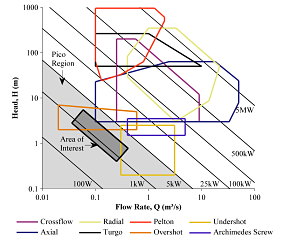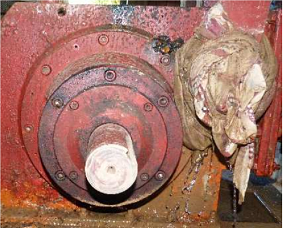Pico and Micro-Hydropower Generation
The UN’s Sustainable Development Goal 7 states that by 2030 we should achieve “modern, sustainable and affordable energy for all”. Generating power from a fall in water has been used across the world to provide energy for society, and in the last two centuries as a way to provide low-carbon electricity. Where the resource exists, it has been shown to be a cheap, reliable method of generating electricity, provide off-grid communities modern energy. Pico- and micro-hydropower generation systems, under 5 kW and 100 kW respectively, are extensively used in developing countries to provide off-grid electrification. We are investigating pico- and micro-hydropower turbine selection, design and implementation issues to support the achievement of Goal 7.
Pico-and Micro-Hydropower Turbine Selection
 Pico and micro-hydropower turbines are often selected based upon hydraulic head and flow rate, as this has been found to be their best operating performance. However, there is often no physical reason why they cannot be used outside the standard ranges. Quantitative criteria, such as efficiency and size, can be combined with qualitative criteria, such as maintainability, serviceability and installation environment requirements, to ensure the most suitable turbine is chosen for a system specification. For example, using this methodology for a specification in a remote community with a low head system that required modular design, a single-jet Turgo turbine was shown to be appropriate, ahead of the typical axial-flow turbine solution.
Pico and micro-hydropower turbines are often selected based upon hydraulic head and flow rate, as this has been found to be their best operating performance. However, there is often no physical reason why they cannot be used outside the standard ranges. Quantitative criteria, such as efficiency and size, can be combined with qualitative criteria, such as maintainability, serviceability and installation environment requirements, to ensure the most suitable turbine is chosen for a system specification. For example, using this methodology for a specification in a remote community with a low head system that required modular design, a single-jet Turgo turbine was shown to be appropriate, ahead of the typical axial-flow turbine solution.
Turgo Turbine Modelling and Testing
 Turgo turbines are impulse turbines, using the change in momentum of a jet of water that impacts a turbine runner to create a mechanical torque on a shaft. Modelling the turbine over a range of heads and flow rates, alongside experimental validation, enables the performance for different environmental conditions to be determined. We have developed an analytical model for a low head Turgo turbine, and verified the model through a scaled experimental testing regime. Using a design of experiments method, we improved the operating water-to-shaft efficiency to 90%. We are working with partners in Nepal to co-develop improvements that can be made in design of the Turgo turbine runner to make it suitable for local workshop manufacture, and measure the performance implication of these design changes.
Turgo turbines are impulse turbines, using the change in momentum of a jet of water that impacts a turbine runner to create a mechanical torque on a shaft. Modelling the turbine over a range of heads and flow rates, alongside experimental validation, enables the performance for different environmental conditions to be determined. We have developed an analytical model for a low head Turgo turbine, and verified the model through a scaled experimental testing regime. Using a design of experiments method, we improved the operating water-to-shaft efficiency to 90%. We are working with partners in Nepal to co-develop improvements that can be made in design of the Turgo turbine runner to make it suitable for local workshop manufacture, and measure the performance implication of these design changes.
Barriers to Good Plant Performance
 We have surveyed of micro-hydropower sites in Nepal to understand the key technical, social and economic issues that lead to poor performance of the plants. This included site assessments, interviews with operators, managers and consumers and discussions with manufacturers. This will lead to the development of methods to address these issues through planning and process changes throughout the design, manufacture, implementation and operation of the system.
We have surveyed of micro-hydropower sites in Nepal to understand the key technical, social and economic issues that lead to poor performance of the plants. This included site assessments, interviews with operators, managers and consumers and discussions with manufacturers. This will lead to the development of methods to address these issues through planning and process changes throughout the design, manufacture, implementation and operation of the system.
PhD Opportunities
Interested in the electric revolution, future of transport or Power Electronics? We're looking for enthusiastic and motivated students to join the EEMG.
Fully funded PhD scholarships for Chinese students to carry out research at the University of Bristol
Contact
For more information please email energy-management@bristol.ac.uk or contact Sam Williamson, Julian Booker or Bernard Stark.